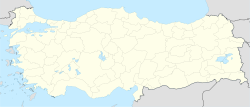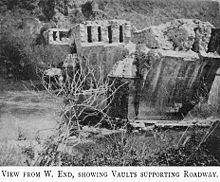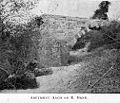- Aesepus Bridge
-
Aesepus Bridge
(Dove Bridge)
Central piers (view from south)Carries Roman road to Kyzikos Crosses Aesepus (Gönen Çayı) Locale Mysia, Turkey Design Arch bridge Material Stone Total length Ca. 158 m Width 5.60 m Longest span 12.20 m Number of spans 11 (incl. floodways) Construction end 4th or 5th/6th cent. AD The Aesepus Bridge (Turkish: Güvercin Köprüsü, "Dove Bridge") was a late antique Roman bridge over the Aesepus river (today Gönen Çayı) in the ancient region of Mysia in modern-day Turkey. It is notable for its advanced hollow chamber system which has also been employed in other Roman bridges in the region, such as the Makestos Bridge. In a field examination carried out in the early 20th century, the four main vaults of the bridge were found in ruins, while nearly all piers and the seven minor arches had still remained intact; the present state of preservation is unknown.
Contents
Location and dating
The Aesepus Bridge is located in northwestern Turkey, 8 km north of Sariköy as the crow flies, approximately 5.6 km upstream of where the Gönen Çayı flows into the Sea of Marmara, slightly above the point where the narrow river valley opens into the wide estuary plain and a modern bridge carries the highway 200 across the Gönen Çayı.[1] The Aesepus Bridge was part of a Roman road, which in ancient times led across Mysia to the coastal town of Cyzicus, and which, having preserved some of its original Roman paving of 13–15 cm deep small round stones, was in the 19th century still the preferred route for travelling between close-by Bandırma (Panderma) and Boghashehr.[2]
The earliest investigation on the Aesepus Bridge was published by the British archaeologist Hasluck in 1906. Going by structural similarities with other hollow chamber bridges in Mysia like the White Bridge and the Makestos Bridge, as well as Constantine's Bridge, he dates the bridge quartet to the early 4th century, in the era of Constantine the Great († 337 AD), when Byzantium was elevated to the capital of the eastern half of the empire.[3]
According to the Italian scholar Galliazzo, though, the characteristic pattern of alternating brick and stone layers in the arch rip (see picture showing the arch of eastern abutment) rather points at an early Byzantine reconstruction from the second half of the 5th or the first of the 6th century, during the reign of Justinian. In his view, only the pier foundations and the abutments with their minor arches are unequivocally of Roman origin.[1]
Structure
While all four main arches had collapsed at the time of Hasluck's visit, both ramps and nearly all bridge piers were still standing to full height; only the third pier from the west bank had completely disappeared.[4] The exposed upper part of the piers showed four parallel, slot-like hollow spaces running through the entire length of the structure, which were meant to reduce the load on the vaults.[5] The piers themselves were protected on their up- and downstream side by large cutwaters with pointed caps.[5]
The bridge is 5.60 m wide[2] and around 158 m long.[1] Hasluck gave the spans of the third and seventh opening as 12.20 m each.[6] The facing, including breakwaters and hollow chambers, consists of granite blocks, whereas the interior is filled with mortar-bound rubble.[5] The well-preserved paving of the remaining roadway is made of large, occasionally squared stones, and rests on the roof slabs of the hollow chambers.[2]
Since the Gönen Çayı at the site passes close to the west slope of the valley, the western abutment is comparatively short.[5] Its two arch vaults, only one of which has a semi-circular shape, were built of brick, with the outer voussoirs alternating between groups of stone and brick, as it is also typical of the Makestos Bridge.[5] The 58 m long eastern ramp rests on five arches of diminishing size (the overgrown arch 9 has only been conjecturally reconstructed by Hasluck).[2] At the approach are the remains of an exedra in brick around which the road forks, an alignment also found at the Sangarius Bridge; a 80 cm high cylindrical stone which may have been used for recording repairs stands next to the exedra.[2]
Gallery
See also
References
- ^ a b c Galliazzo 1995, p. 417
- ^ a b c d e Hasluck 1905/06, p. 187
- ^ Hasluck 1905/06, p. 189
- ^ Hasluck 1905/06, p. 184f.
- ^ a b c d e Hasluck 1905/06, p. 185
- ^ Hasluck 1905/06, pp. 185, 187
Sources
- Galliazzo, Vittorio (1994), I ponti romani. Catalogo generale, Vol. 2, Treviso: Edizioni Canova, p. 417, ISBN 88-85066-66-6
- Hasluck, Frederick William (1905/06), "A Roman Bridge on the Aesepus", The Annual of the British School at Athens 12: 184–189
External links
 Media related to Aesepus Bridge at Wikimedia Commons
Media related to Aesepus Bridge at Wikimedia CommonsRoman bridges England France Pont Ambroix • Pont de Bornègre • Pont Flavien • Pont du Gard • Pont Julien • Pont sur la Laye • Pont des Marchands • Pont Serme • Roman Bridge (Saint-Thibéry) • Roman Bridge (Vaison-la-Romaine) Germany Iran Band-e Kaisar Italy Pons Aemilius • Pons Agrippae • Ponte Altinate • Pons Cestius • Pons Fabricius • Pons Neronianus • Pons Probi • Pons Sublicius • Pont d'Aël • Pont de Pierre (Aosta) • Pont-Saint-Martin • Ponte d'Augusto (Rimini) • Ponte Corvo • Ponte del Gran Caso • Ponte Milvio • Ponte Molino (Padua) • Ponte Nomentano • Ponte Pietra (Verona) • Ponte di Pioraco • Ponte di Quintodecimo • Ponte Salario • Ponte San Lorenzo • Ponte Sant'Angelo • Susegana Bridge Lebanon Leontes Bridge Portugal Ponte de Rubiães • Ponte Nova da Cava da Velha • Roman Bridge (Chaves) Romania Spain Acueducto de los Milagros • Alcántara Bridge • Alcántara Bridge (Toletum) • Alconétar Bridge • Aqüeducte de les Ferreres • Puente Romano (Mérida) • Segovia Aqueduct Bridge Syria Bridge at Nimreh • Gemarrin Bridge • Kharaba Bridge Turkey Aesepus Bridge • Arapsu Bridge • Bridge at Oinoanda • Constantine's Bridge (Mysia) • Eurymedon Bridge (Aspendos) • Eurymedon Bridge (Selge) • Karamagara Bridge • Kemer Bridge • Limyra Bridge • Makestos Bridge • Nysa Bridge • Penkalas Bridge • Pergamon Bridge • Sangarius Bridge • Severan Bridge • Taşköprü (Adana) • Valens Aqueduct Bridge • White Bridge (Mysia)
Coordinates: 40°16′36″N 27°36′12″E / 40.27667°N 27.60333°ECategories:- Roman bridges in Turkey
- Deck arch bridges
- Stone bridges
- Mysia
Wikimedia Foundation. 2010.







